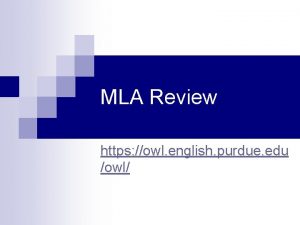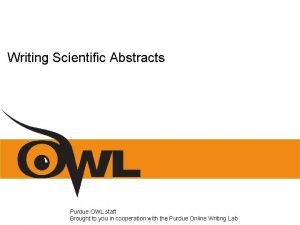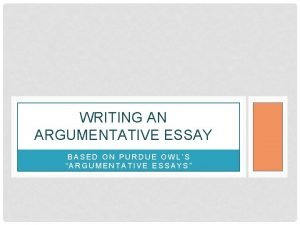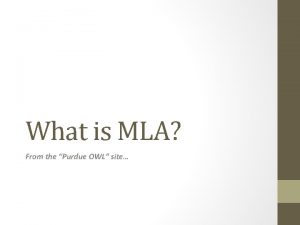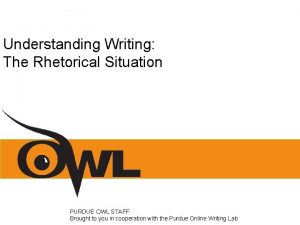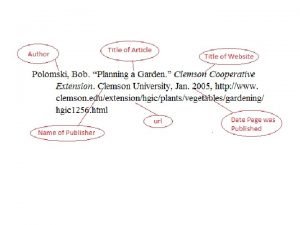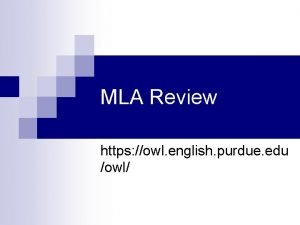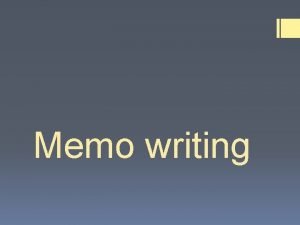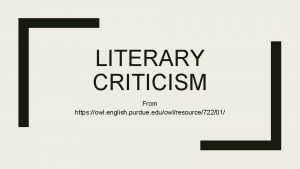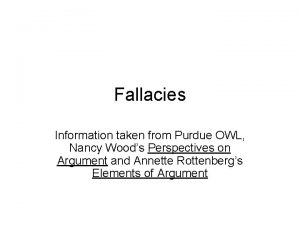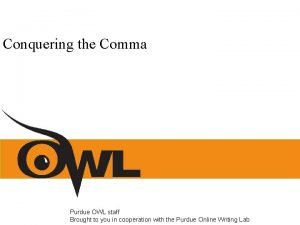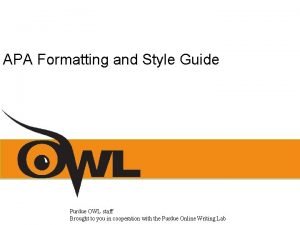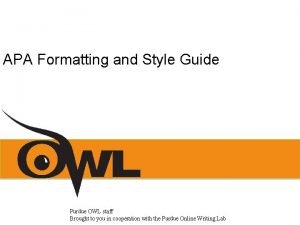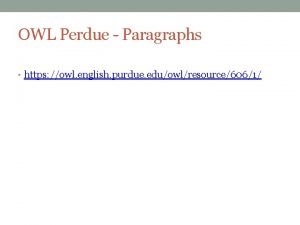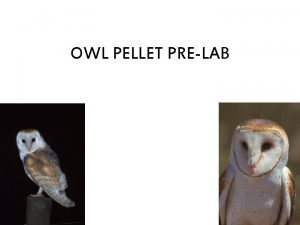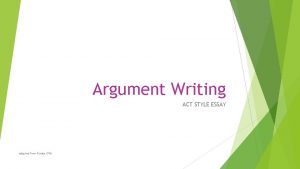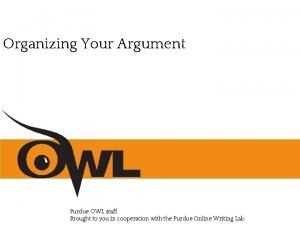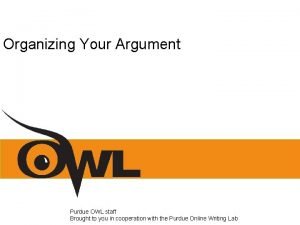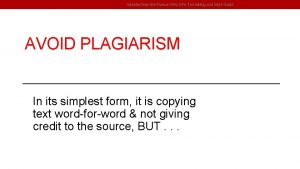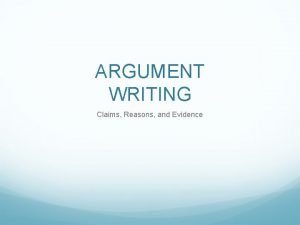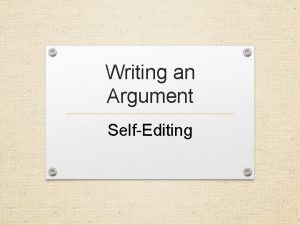Argument Writing adapted from Purdue OWL Where to
















- Slides: 16

Argument Writing adapted from Purdue OWL

Where to begin… Start with making sure you understand what the question is asking. Brainstorm ideas for both sides of the argument and decide which side you can make the strongest case for. Taking a few minutes to do this, can really help especially when it is a timed writing situation like the exam, ACT, SAT, etc. adapted from Purdue OWL

Finding your voice: Rules for academic writing… Avoid using contractions Avoid using the impersonal you, “we”, “I”, “me”, “us”, “our”, and anything else to the likes (unless writing about personal experience). Easy fix? Use the word “one” Avoid using the word “their” when you mean “there”. Or “then” when you mean “than”. Avoid using slang. Use “children” rather than “kids”, and “police officer” rather than “cop”. If you are writing about a person, do not refer to them by their first name, i. e. “Arthur wrote the play after being questioned by the House Un-American Activities Committee. ” Either use his whole name or just the last name, i. e. “Miller wrote the play after being questioned by the House Un-American Activities Committee. ” Avoid using words like “never” and “always” unless you have a citation for confirmation. adapted from Purdue OWL

Introduction Paragraph - getting started is often the hardest part The introduction is the broad beginning of the paper that answers three important questions: What Why is this? am I reading it? What do you want me to do? adapted from Purdue OWL

Introduction Paragraph - getting started is often the hardest part What your introduction paragraph should do: Ø set up the context of the topic in a general way (in other words, introduce the topic) Ø show why this topic is important and why the audience should care about this issue Ø contain a clear, concise thesis statement (or claim) that is debatable adapted from Purdue OWL

Introduction Paragraph adapted from Purdue OWL

Thesis Statement A clear statement that is arguable. According to the MLA Handbook for Writers of Research Papers, Seventh Edition, "A thesis statement is a single sentence that formulates both your topic and your point of view" (Gibaldi 42). It needs to establish a clear position you will support with balanced proofs (logos, pathos, ethos). The thesis/claim seems supportable by good reasoning/data, emotional appeal adapted from Purdue OWL

Structure of Argument Essay - What holds the essay together… A clear, concise, and defined thesis statement that occurs in the first paragraph of the essay. Clear and logical transitions between the introduction, body, and conclusion Body paragraphs that include evidential support and explain how and why the evidence supports thesis (warrant) Evidential support (whether factual, logical, statistical, or anecdotal) from multiple points of view; this includes a counterargument (evidence that may not support your thesis) A conclusion that does not simply restate thesis, but readdresses it in light of the evidence provided. adapted from Purdue OWL

A Complete Argument… “Perhaps it is helpful to think of an essay in terms of a conversation or debate with a classmate” (Purdue OWL) adapted from Purdue OWL

Body paragraphs: Moving from general to specific information A good paragraph should contain at least the following four elements: Transition, Topic sentence, specific Evidence and analysis, and a Brief wrap-up sentence (also known as a warrant) –TTEB! adapted from Purdue OWL A Transition sentence leading in from a previous paragraph to assure smooth reading. This acts as a hand off from one idea to the next. A Topic sentence that tells the reader what you will be discussing in the paragraph. Specific Evidence and analysis that supports one of your claims and that provides a deeper level of detail than your topic sentence. A Brief wrap-up sentence that tells the reader how and why this information supports the paper’s thesis. The brief wrap-up is also known as the warrant. The warrant is important to your argument because it connects your reasoning and support to your thesis, and it shows that the information in the paragraph is related to your thesis and helps defend it.

Writing About Literature Do not assume that your audience is familiar with the text. Give a sentence or two summary as to what the text is about and how/why it relates. Only tell what they would need to know to understand your example. For our essay, I am requiring that you incorporate a quote from the text (you would not do this on a timed test). When incorporating quotes, remember: Quotes cannot stand alone!!! Quotes need to be introduced and explained. Remember to include the author and page number after the quote or (Miller 52). The punctuation goes after the citation Book titles need to be capitalized and in italics; short story and essay titles are capitalized and in quotation marks adapted from Purdue OWL

Incorporating Quotations Include an attributive tag such as… Miller writes, “…. . ” (pg #). Or Proctor says, “…. ” (Miller 5). Ø Incorporate as part of the sentence… Abigail, who has an “endless capacity for dissembling” (Miller pg#), is an unlikeable character. Introduce with a complete sentence followed by a quote that is a complete sentence… Miller introduces Reverend Parris as an unlikeable character from the very beginning of the play: “In history he cut a villainous path, and there is little good to be said for him” (3). adapted from Purdue OWL

Counterclaim & Rebuttal In order to present a fair and convincing argument, you may need to anticipate and outline some of the common positions (arguments) that dispute your thesis/claim. This also increases your credibility as a writer (ethos) Consider your audience: “People who are on your side of the argument will not need a lot of information to align with your position. People who are completely against your argument—perhaps for ethical or religious reasons— will probably never align with your position no matter how much information you provide. Therefore, the audience you should consider most important are those people who haven't decided which side of the argument they will support—the fence-sitters” (Purdue OWL) adapted from Purdue OWL

Organizing your Counterclaim & Rebuttal Start by explaining the opposing viewpoint Restate Explain your viewpoint why your viewpoint is right in an objective manner. adapted from Purdue OWL

Conclusion In a general way, Restate your topic and why it is important, Restate your thesis/claim, Address opposing viewpoints and explain why readers should align with your position, Give your reader something to think about (a call to action) in regards to your topic. adapted from Purdue OWL

Last steps… The hard part is over! Read through your paper and make revisions. Ask someone else to do the same. Make changes and review as many times as needed. Turn in a hard copy to Mrs. Hayes and upload on Turnitin. com. adapted from Purdue OWL
 Owl.english.purdue.edu mla
Owl.english.purdue.edu mla Purdue owl abstract example
Purdue owl abstract example Purdue owl persuasive essay
Purdue owl persuasive essay Purdue owl works cited
Purdue owl works cited Rhetorical devices purdue owl
Rhetorical devices purdue owl Perdue owl
Perdue owl All of the cds, even the scratched one,
All of the cds, even the scratched one, Purdue owl
Purdue owl Task segment of a memo
Task segment of a memo Owl purdue feminist criticism
Owl purdue feminist criticism Owl purdue annotated bibliography
Owl purdue annotated bibliography Owl purdue fallacies
Owl purdue fallacies Email spacing etiquette
Email spacing etiquette Comma splices purdue owl
Comma splices purdue owl Purdue owl introduction paragraph
Purdue owl introduction paragraph Purdue owl apa example
Purdue owl apa example Purdue owl mla in-text citation
Purdue owl mla in-text citation
